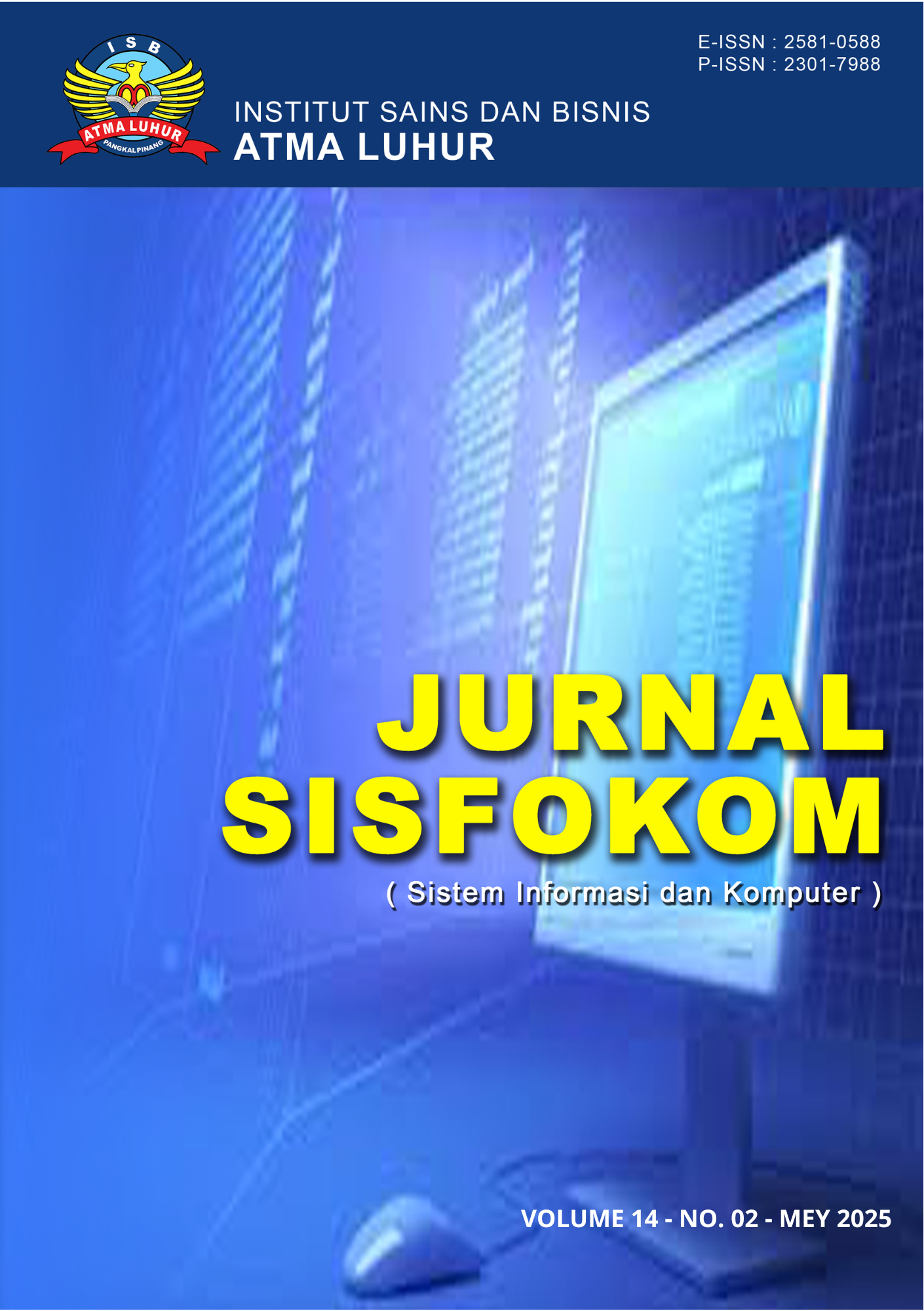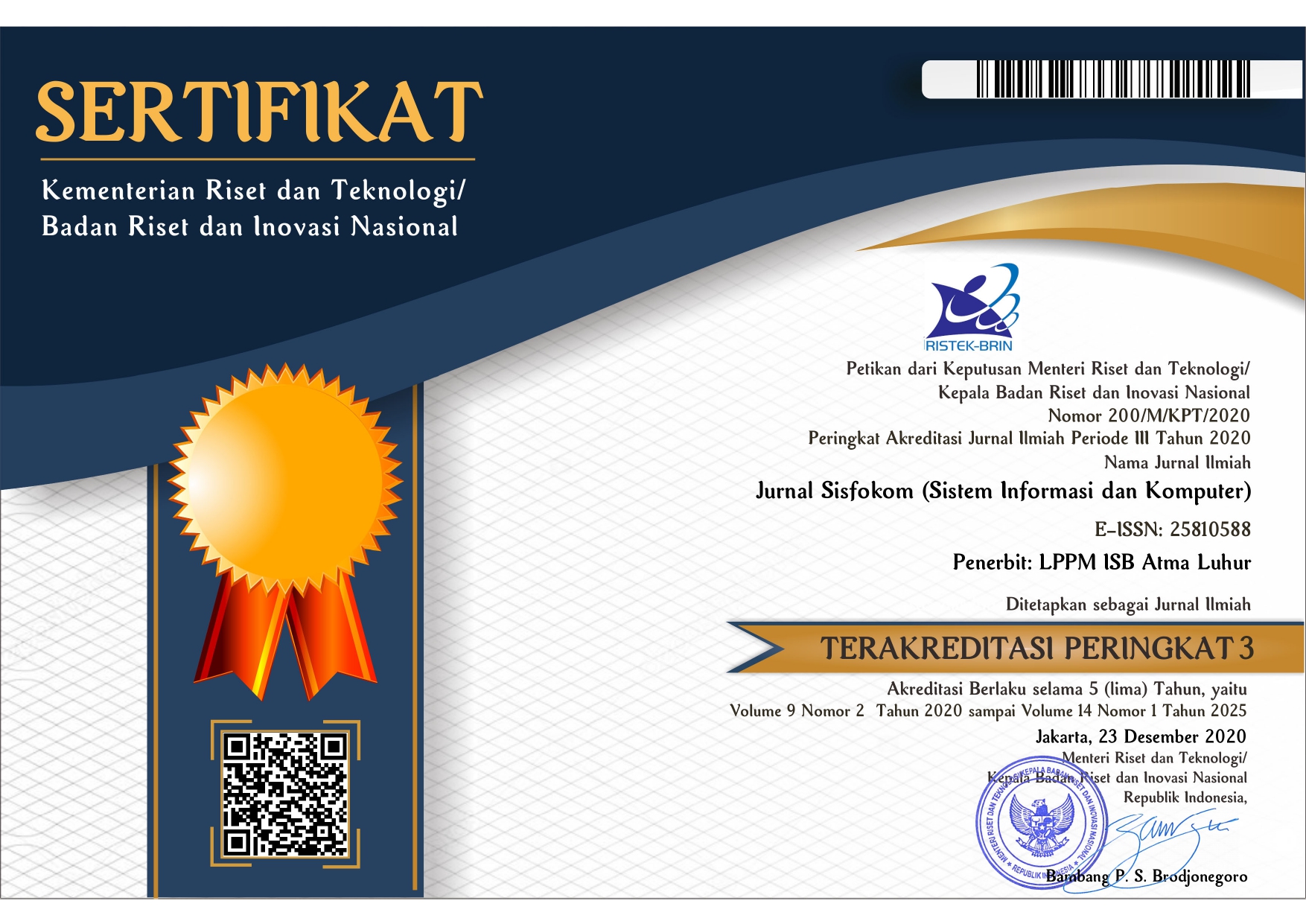The Effect of SMOTE and Optuna Hyperparameter Optimization on TabNet Performance for Heart Disease Classification
DOI:
https://doi.org/10.32736/sisfokom.v14i2.2348Keywords:
TabNet, SMOTE, Optuna, Classification, Heart DiseaseAbstract
Heart disease is a medical condition affecting the cardiovascular system, disrupting blood circulation and reducing cardiac function efficiency, which can lead to severe health complications. Early diagnosis of heart disease has become increasingly crucial as delayed detection can significantly impact patient outcomes and survival rates. While numerous studies have explored various approaches for heart disease classification, challenges related to data imbalance and improper parameter settings remain persistent issues that affect model performance. This research evaluated the effectiveness of combining TabNet with SMOTE and optuna hyperparameter optimization for heart disease classification. We conducted four experimental scenarios using a heart disease dataset with 303 instances: baseline TabNet, baseline TabNet with SMOTE, TabNet with Optuna, and TabNet with both SMOTE and Optuna. Results demonstrated that applying SMOTE alone to TabNet decreased model performance (accuracy from 85.24% to 77.04%, AUC from 0.89 to 0.83). However, when combining SMOTE with Optuna hyperparameter optimization, we achieved optimal performance with 90.16% accuracy, 93.33% precision, 87.50% recall, 90.32% F1-score, and 0.93 AUC. This represented a significant improvement over other configurations and several previous classification approaches. The integration of SMOTE with Optuna optimization provided an effective framework for heart disease classification that outperformed traditional methods particularly in discriminative capability as evidenced by the superior AUC score.References
G.A. Roth, C. Johnson, A. Abajobir, F. Abd-Allah, S.F. Abera, G. Abyu, et al., "Global, regional, and national burden of cardiovascular diseases for 10 causes, 1990 to 2015," J. Am. Coll. Cardiol., vol. 70, no. 1, pp. 1-25, 2017.
M.I. Jordan and T.M. Mitchell, "Machine learning: Trends, perspectives, and prospects," Science, vol. 349, no. 6245, pp. 255-260, 2015.
S. Falkner, A. Klein, and F. Hutter, "Practical hyperparameter optimization for deep learning," in AutoML: Methods, Systems, Challenges, F. Hutter, L. Kotthoff, and J. Vanschoren, Eds., Cham: Springer, pp. 3-25, 2018.
A. Homaidi and Z. Fatah, "Implementasi metode K-nearest neighbors (KNN) untuk klasifikasi penyakit jantung," G-Tech: Jurnal Teknologi Terapan, vol. 8, no. 3, pp. 1720-1728, 2024.
A. Masruriyah, H. Novita, C. Sukmawati, A. Ramadhan, S. Arif, and B. Dermawan, "Pengukuran kinerja model klasifikasi dengan data oversampling pada algoritma supervised learning untuk penyakit jantung," Computer Science (CO-SCIENCE), vol. 4, no. 1, pp. 62-70, 2024.
S.Ö. Arik and T. Pfister, "TabNet: Attentive interpretable tabular learning," in Proc. AAAI Conf. Artif. Intell., vol. 35, no. 8, pp. 6679-6687, May 2021.
A.R. Raharja, A. Pramudianto, and Y. Muchsam, "Penerapan algoritma decision tree dalam klasifikasi data ‘Framingham’ untuk menunjukkan risiko seseorang terkena penyakit jantung dalam 10 tahun mendatang," Technol. J., vol. 1, no. 1, 2024.
D. Nasien, et al., "Klasifikasi penyakit jantung menggunakan decision tree dan KNN menggunakan ekstraksi fitur PCA," JEKIN-Jurnal Teknik Informatika, vol. 4, no. 1, pp. 18-24, 2024.
T. Indriyani, et al., "Metode decision tree C4.5 untuk klasifikasi penyakit jantung," Prosiding Seminar Nasional Sains dan Teknologi Terapan, no. 1, 2024.
J.J. Tamilselvi and C.B. Gifta, "Handling duplicate data in data warehouse for data mining," Int. J. Comput. Appl., vol. 15, no. 4, pp. 7-15, 2011.
S.K. Kwak and J.H. Kim, "Statistical data preparation: Management of missing values and outliers," Korean J. Anesthesiol., vol. 70, no. 4, pp. 407, 2017.
J. Brownlee, Imbalanced Classification with Python: Better Metrics, Balance Skewed Classes, Cost-Sensitive Learning, Machine Learning Mastery, 2020.
T. Akiba, S. Sano, T. Yanase, T. Ohta, and M. Koyama, "Optuna: A next-generation hyperparameter optimization framework," in Proc. 25th ACM SIGKDD Int. Conf. Knowl. Discov. Data Min., pp. 2623-2631, July 2019.
C. Sammut and G. I. Webb, Eds., Encyclopedia of Machine Learning, Springer Science & Business Media, 2011.
S. Sathyanarayanan and B. R. Tantri, “Confusion matrix-based performance evaluation metrics,” Afr. J. Biomed. Res., vol. 4023, pp. 4023-4031, 2024.
A. Tafvizi, B. Avci, and M. Sundararajan, “Attributing AUC-ROC to analyze binary classifier performance,” arXiv preprint arXiv:2205.11781, 2022.
B. Hirwono, A. Hermawan, and D. Avianto, “Implementasi metode Naïve Bayes untuk klasifikasi penderita penyakit jantung,” J. JTIK (Jurnal Teknol. Inf. Komun.), vol. 7, no. 3, pp. 450-457, 2023.
H. M. Nawawi, J. J. Purnama, and A. B. Hikmah, “Komparasi algoritma neural network dan Naïve Bayes untuk memprediksi penyakit jantung,” J. Pilar Nusa Mandiri, vol. 15, no. 2, pp. 189-194, 2019.
R. Firdaus, D. Mualfah, and J. S. Hasanah, “Klasifikasi multi-class penyakit jantung dengan SMOTE dan Pearson’s correlation menggunakan MLP,” J. CoSciTech (Comput. Sci. Inf. Technol.), vol. 4, no. 1, pp. 262-271, 2023.
M. D. I. Baliani, R. R. Huizen, and G. A. Pradipta, “Perbandingan performa data penyakit jantung menggunakan pendekatan klasifikasi boosting methods,” in Seminar Hasil Penelitian Informatika dan Komputer (SPINTER), Institut Teknologi dan Bisnis STIKOM Bali, 2024, pp. 894-899.
A. J. Wahidin, A. E. Setiawan, and P. Bintoro, “Machine learning untuk klasifikasi penyakit jantung,” Aisyah J. Inf. Electr. Eng. (AJIEE), vol. 6, no. 1, pp. 145-150, 2024.
Downloads
Published
Issue
Section
License

This work is licensed under a Creative Commons Attribution 4.0 International License.
The copyright of the article that accepted for publication shall be assigned to Jurnal Sisfokom (Sistem Informasi dan Komputer) and LPPM ISB Atma Luhur as the publisher of the journal. Copyright includes the right to reproduce and deliver the article in all form and media, including reprints, photographs, microfilms, and any other similar reproductions, as well as translations.
Jurnal Sisfokom (Sistem Informasi dan Komputer), LPPM ISB Atma Luhur, and the Editors make every effort to ensure that no wrong or misleading data, opinions or statements be published in the journal. In any way, the contents of the articles and advertisements published in Jurnal Sisfokom (Sistem Informasi dan Komputer) are the sole and exclusive responsibility of their respective authors.
Jurnal Sisfokom (Sistem Informasi dan Komputer) has full publishing rights to the published articles. Authors are allowed to distribute articles that have been published by sharing the link or DOI of the article. Authors are allowed to use their articles for legal purposes deemed necessary without the written permission of the journal with the initial publication notification from the Jurnal Sisfokom (Sistem Informasi dan Komputer).
The Copyright Transfer Form can be downloaded [Copyright Transfer Form Jurnal Sisfokom (Sistem Informasi dan Komputer).
This agreement is to be signed by at least one of the authors who have obtained the assent of the co-author(s). After submission of this agreement signed by the corresponding author, changes of authorship or in the order of the authors listed will not be accepted. The copyright form should be signed originally, and send it to the Editorial in the form of scanned document to sisfokom@atmaluhur.ac.id.









